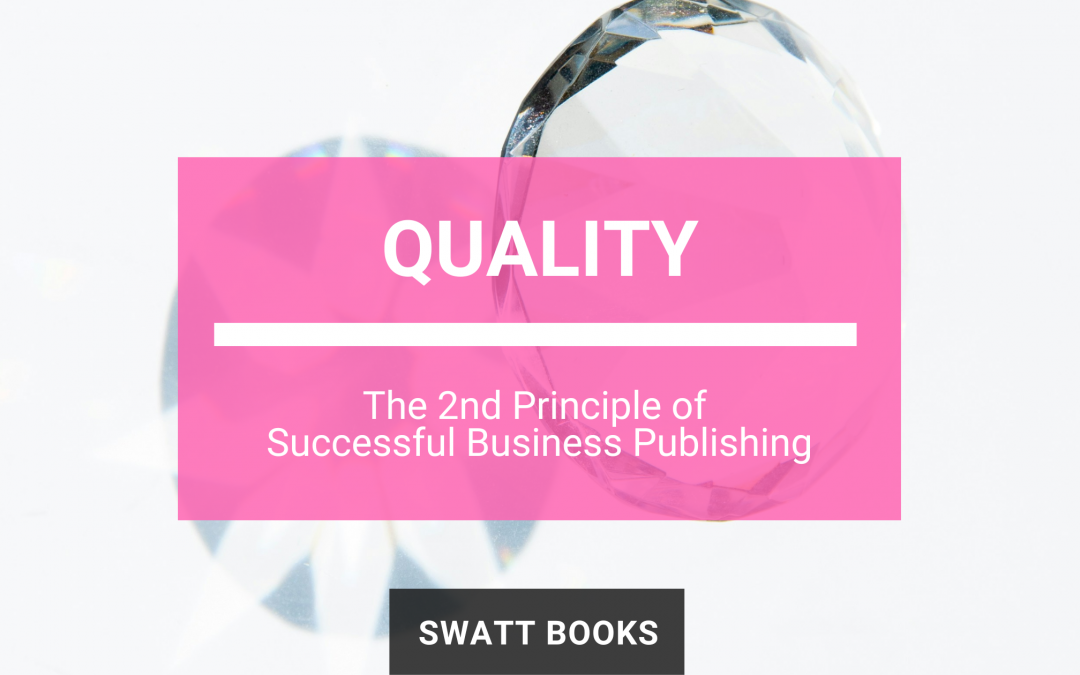Welcome to the 2nd of our five-part article series on the Principles of Successful Business Publishing. In the previous article, I introduced you to the five principles and specifically how ensuring that your book is aligned with your overall business is important to publishing a book that will have a long-lasting positive impact.
The next principle is Quality: ensuring that you publish a professional book that is a true reflection of your business. This is vitally important to the success of your book as well as guaranteeing that your book leaves a positive and professional first impression.
The quality of your book directly reflects on your brand; for better or for worse. Both subtle and overt cues about your book’s quality will have considerable influence over a reader’s perception of you and in turn your business. Modern readers have much higher expectations than they did 20-30 years ago, and they expect a certain level of quality in both presentation and content when they make an investment of time and money in a book.
As a self-respecting and successful business owner, I don’t need to lecture you on the importance of quality. But what sorts of things do you need to be mindful of to ensure that your book achieves a sufficiently high standard of quality?
1. Cover Design
The very first impression someone is going to have of your book is the front cover. I know that most people try to live by the adage of ‘don’t judge a book by its’ cover’, but that is exactly what 99% of readers will do with your book, especially if you are an unknown author to them. So, it is vitally important to have a well-designed cover that is visually appealing.
2. Editing & Proofreading
There is nothing more off-putting than a book that is riddled with mistakes, inconsistencies, and repetition. The role of a professional editor and/or proofreader in the publishing process cannot be overstated enough. They will ensure that your book is both error-free and help improve the quality of your writing and therefore the reader experience.
3. Content & Structure
Having a clear and logical structure that guides a reader through your book effectively also has an impact on the perceived quality of a book. Making a reader work to connect the various threads of your topic will only leave them thinking that you do not have a clear grasp of your subject.
4. Typography & Formatting
Typography choices and formatting contribute heavily to the overall readability and aesthetic appeal of your book and are vitally important to get right. Minute changes in font choice, text size, word, and line spacing, margins, and heading hierarchy can all impact how easy or difficult your book is to read and understand.
5. Image Quality
If your book includes images, whether they are photographs, illustrations, technical drawings, or simply charts and graphs, they need to be high quality and well thought out to enhance your book’s content as opposed to distracting away from it. Just pulling images off the internet will not cut it!
6. Consistency in Branding
Whether you plan on infusing your book with your company’s corporate branding aesthetic or are going to create a unique branding style specifically for your book, you must apply branding elements such as colours, fonts, and logos consistently throughout the entire book.
7. Printing & Binding
In terms of the physically printed copies of your book, it is important to ensure that the print quality, paper stock, and binding are of a high enough standard to create a book that is both professional in appearance and robust enough to endure multiple readings.
8. eBook Formatting & Compatibility
As with printed copies of your book, digital eBook editions also need care and attention to ensure that the formatting as closely resembles the print version as is possible within the confines of eBook technology. You also need to put your eBook through rigorous testing to guarantee compatibility across multiple e-reader devices.
So how do you go about ensuring that your book meets all the above quality standards?
The best place to start is with your competitors. Analyse other books both in your genre and from author business authors you admire. Note what similarities they all have in terms of printing, binding, design, and formatting so that you have a benchmark to aim for when producing your book.
It’s a good idea to have conversations with printers, publishers, author services or self-publishing platforms to gain a greater understanding of the process, what is involved and how they can potentially help you to produce a high-quality book.
It is also important to realise that a book is a living thing, it can adapt and change over time; in fact, it should do to remain relevant. This allows you the opportunity to continually invest in the improvement of your book over time, allowing it to reflect your increasing growth and expertise.
But above all, set aside a budget for professional services like editors, designers and typesetters who can help you to produce the best quality book possible. If you are going to take the time and effort to write and publish a book, then you owe it to yourself and to your readers to do it properly, and bringing experienced support into the project will help you achieve that.





